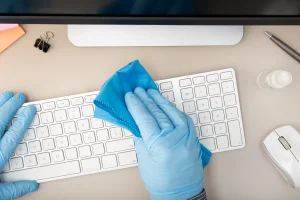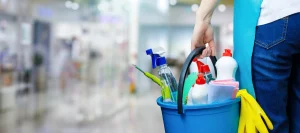Maintaining a clean, sanitised and safe office environment has never been more important than during the pandemic. As more and more businesses welcome their staff back into the workplace, it is vital that offices are thoroughly cleaned and sanitised on a regular basis to minimise the risk of illness spreading through the workforce. But what exactly is the difference between office cleaning and office sanitising, and why is the difference important?
Cleaning
Cleaning involves the removal of very obvious debris, dirt and organic substances from surfaces and floors. Dusting, vacuuming, and wiping surfaces down with hot soapy water are all common methods of cleaning that should be carried out regularly, particularly in areas of the office which get a lot of footfall.
Surfaces that should be cleaned regularly in an office include floors, windows, desks, keyboards, printers, photocopiers, and door handles. Not only does regular cleaning help to keep an office looking tidy and professional, but it also helps to prevent bacteria from growing on surfaces and posing a health risk. Plus, carpets and surfaces that are routinely cleaned are likely to stay in good condition for longer and require less frequent replacement.
Sanitising
Sanitising involves the removal of bacteria and contaminants that could lead to infection. Sanitising usually involves a sanitising cleanser that kills 99.9% of bacteria, and it is particularly important to sanitise regularly in areas that are frequently exposed to bacteria, such as food preparation areas and bathrooms.
Although sanitising does not kill all viruses, it is an important way to decrease the risk of common infections. Regular sanitising helps to prevent many common illnesses, which is vital in an office environment where sickness can spread very quickly between members of staff who are working in close quarters.
What about disinfecting?
Disinfecting is the complete removal of all microorganisms and pathogens which could cause disease. It is a process that tends to be reserved for medical environments, and is typically only used in offices if there has been an outbreak of a disease which must be controlled via a very deep clean.
Cleaning always occurs before sanitising
Although sanitising seems to be a more thorough form of cleaning, the two actually go hand in hand and cleaning always occurs before sanitising. For example, food debris ought to be cleaned from kitchen surfaces before a sanitising detergent is used to remove lasting bacteria. Without cleaning the food debris first, the sanitising process will be less effective.
Commercial cleaning providers have a good understanding of the differences between cleaning and sanitising, as well as the cleaning processes and protocols needed to ensure that an office environment is hygienic and safe.
At Clean All Crew, our office cleaning services are reliable and cost-effective, and you can rest assured that we’ll keep your workplace looking spotless. Contact us for more information on our London commercial cleaning service.




